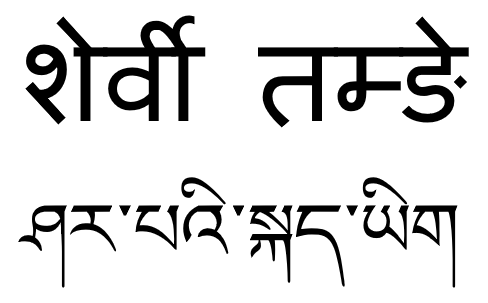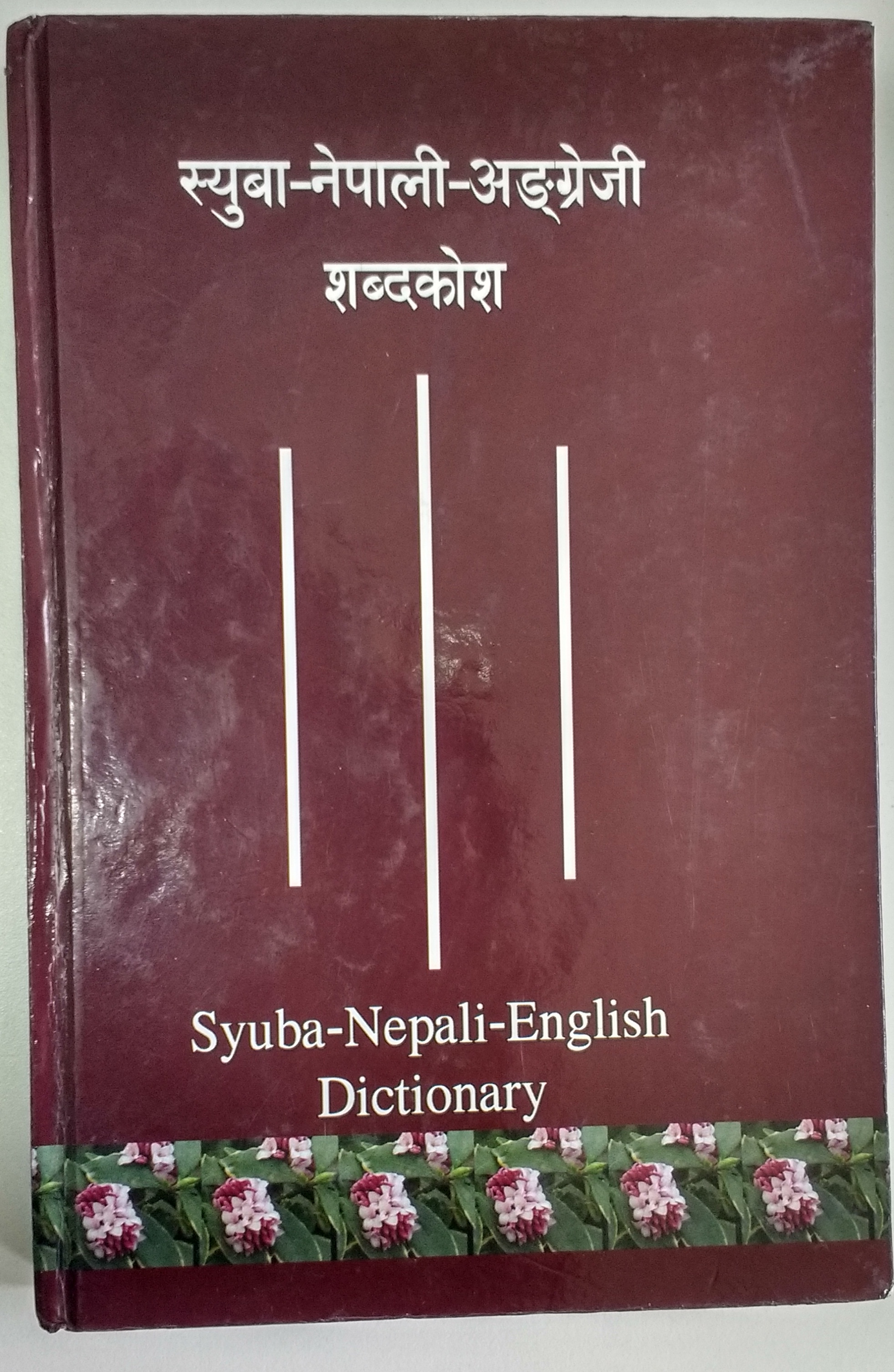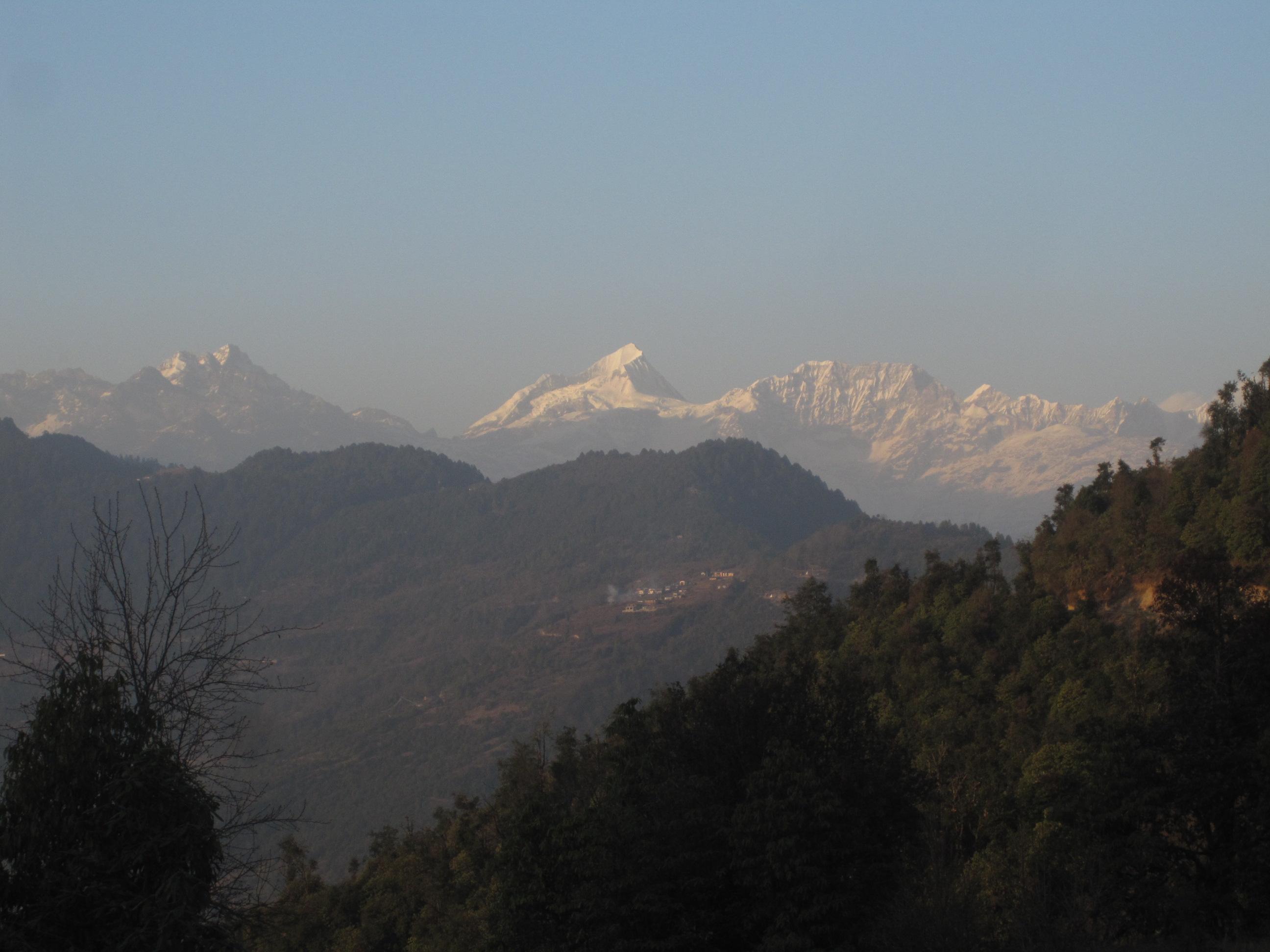|
Sherpa Language
Sherpa (also Sharpa, Sherwa, or Xiaerba) is a Tibetic language spoken in Nepal and the Indian state of Sikkim, mainly by the Sherpa. The majority speakers of the Sherpa language live in the Khumbu region of Nepal, spanning from the Chinese (Tibetan) border in the east to the Bhotekosi River in the west. About 127,000 speakers live in Nepal (2021 census), some 16,000 in Sikkim, India (2011), and some 800 in the Tibetan Autonomous Region (1994). Sherpa is a subject-object-verb (SOV) language. Sherpa is predominantly a spoken language, although it is occasionally written using either the Devanagari or Tibetan script. Classification Sherpa belongs to the Tibetic branch of the Tibeto-Burman family. It is closely related to Central Tibetan, Jirel, Humla, Mugom, Dolpo, Lo-ke, Nubri, Tsum, Langtang, Kyirong, Yolmo, Gyalsumdo, Kagate, Lhomi, Walung, and Tokpe Gola. Literary Tibetan ''LT''- becomes /lh/ and ''SR-'' becomes /ʈ/. There are five closely related dialect ... [...More Info...] [...Related Items...] OR: [Wikipedia] [Google] [Baidu] [Amazon] |
SOV Language
SOV may refer to: * SOV, a former ticker symbol for Sovereign Bank * SOV, a legal cryptocurrency created by the Sovereign Currency Act of 2018 of the Republic of the Marshall Islands * SOV, the National Rail station code for Southend Victoria railway station, Southend-on-Sea, England * SO Voiron, a French rugby union club * Schedule of values * Shot-on-video film * Single-occupancy vehicle * Subject–object–verb, used in linguistic typology * Symphony Orchestra Vorarlberg, an Austrian orchestra * Share of voice * Sorin Ovidiu Vântu, a Romanian business man * Store of value A store of value is any commodity or asset that would normally retain purchasing power into the future and is the function of the asset that can be saved, retrieved and exchanged at a later time, and be predictably useful when retrieved. The most ... * Strenght of victory, the combined record of all teams beaten in a schedule in the NFL {{Disambiguation ... [...More Info...] [...Related Items...] OR: [Wikipedia] [Google] [Baidu] [Amazon] |
Bantawa Language
The Bantawa Language (also referred to as An Yüng, Bantaba, Bantawa Dum, Bantawa Yong, Bantawa Yüng, Bontawa, Kirawa Yüng), is a Kiranti language spoken in the eastern Himalayan hills of eastern Nepal by Kirati Bantawa ethnic groups. They use a syllabic alphabet system known as Kirat Rai. Among the Khambu or Rai people of Koshi Province in Nepal, Sikkim, Darjeeling and Kalimpong in India, Bantawa is the most extensively spoken language. According to the 2001 National Census, at least 1.63% of the Nepal's total population speaks Bantawa. About 370,000 speak Bantawa language mostly in eastern hilly regions of Nepal (2001). Although Bantawa is among the more widely used variety of the Bantawa language, it falls in the below-100,000 category of endangered languages. It is experiencing language shift to Nepali, especially in the northern region. Bantawa is spoken in subject-object-verb order, and has no noun classes or genders. Dialects Most of the Bantawa clan are now settle ... [...More Info...] [...Related Items...] OR: [Wikipedia] [Google] [Baidu] [Amazon] |
Kagate Language
Kagate or Syuba is a language from the subgroup of Tibetic languagesN. Tournadre (2005) "L'aire linguistique tibétaine et ses divers dialectes." ''Lalies'', 2005, n°25, p. 7–5/ref> spoken by the Kagate people primarily in the Ramechhap District, Ramechhap district of Nepal. Language name ''Kagate'' is an exonym. It is the Nepali word for the occupation of 'papermaker', reflecting an earlier occupation of the community. This is the name under which the language was documented in Grierson's 1909 linguistic survey of India, and by which it is classified in the ISO 639-3 code. Speakers now prefer the endonym ''Syuba,'' which also refers to the occupation of papermaker. This name is mentioned in documentation literature from the 1970s, and speakers are now using this form more actively, see as an example the Syuba-Nepali-English dictionary. History Kagate speakers migrated from the Yolmo area of Helambu around 100–200 years ago. This was likely the result of populat ... [...More Info...] [...Related Items...] OR: [Wikipedia] [Google] [Baidu] [Amazon] |
Gyalsumdo Language
Gyalsumdo () is a mostly undocumented Tibetic language spoken by an estimated 200 individuals of the Manang District in the Gandaki Zone of Nepal. In January 2018 the language was added to ISO 639-3 under the code "gyo." Gyalsumdo is a tonal language; however in Gyalsumdo, unlike most other Central Tibetan Central Tibetan language, also known as Dbus Tibetan, Ü Tibetan or Ü-Tsang Tibetan, is the most widely spoken Tibetic language and the basis of Standard Tibetan. ''Dbus'' is the Wylie spelling of the name in Tibetan script, , whereas ''Ü'' is ... languages, the word, rather than the syllable acts as the tone bearing unit. The language is reportedly closely related to the nearby Nubri and Tsum languages which share a large proportion of vocabulary. Gyalsumdo is also described as being somewhat intelligible by speakers of Nar-Phu. References Manang District, Nepal Languages of Nepal Endangered languages of Asia Endangered Sino-Tibetan languages {{nepal- ... [...More Info...] [...Related Items...] OR: [Wikipedia] [Google] [Baidu] [Amazon] |
Yolmo Language
Yolmo (Hyolmo) or Helambu Sherpa, is a w:Tibeto-Burman languages, Tibeto-Burman language of the w:Yolmo people, Hyolmo people of Nepal (ISO 639-3: iso639-3:scp, scp, GlottoCodeyolm1234. Yolmo is spoken predominantly in the w:Helambu, Helambu and w:Melamchi, Melamchi valleys in northern w:Nuwakot District, Nuwakot District and northwestern w:Sindhupalchowk District, Sindhupalchowk District. Dialects are also spoken by smaller populations in w:Lamjung District, Lamjung District and w:Ilam District, Ilam District and also in w:Ramechhap District, Ramecchap District (where it is known as w:Kagate language, Syuba). It is very similar to w:Kyirong language, Kyirong Tibetan and less similar to w:Standard Tibetan, Standard Tibetan and w:Sherpa language, Sherpa. There are approximately 10,000 Yolmo speakers, although some dialects have larger populations than others. Language name Yolmo is both the name of the language (w:glottonym, glottonym), and the ethnic group of w:Yolmo people, p ... [...More Info...] [...Related Items...] OR: [Wikipedia] [Google] [Baidu] [Amazon] |
Kyirong Language
Kyirong is a language from the subgroup of Tibetic languagesN. Tournadre (2005) "L'aire linguistique tibétaine et ses divers dialectes." ''Lalies'', 2005, n°25, p. 7–5/ref> spoken in the Gyirong County of the Shigatse prefecture, of the Tibetan Autonomous Region. Kyirong has lexical tone Tone is the use of pitch in language to distinguish lexical or grammatical meaning—that is, to distinguish or to inflect words. All oral languages use pitch to express emotional and other para-linguistic information and to convey emphasis ..., with a three-tone system. Relationship to other languages There is a varying degree of mutual intelligibility between Kyirong and other Kyirong-Yolmo varieties. It is most closely related to the Nubri and Gyalsomdo languages, and more distantly related to other languages in the family. Phonology Consonants There are 36 consonants in Kyirong, which are summarized in the table below. Vowels There are eight places of articulati ... [...More Info...] [...Related Items...] OR: [Wikipedia] [Google] [Baidu] [Amazon] |
Kyirong–Kagate Languages
Kyirong–Kagate is a subgroup of Tibetic languages spoken primarily in Nepal, with a hundred or so speakers across the border in Tibet. Varieties are:N. Tournadre (2005) "L'aire linguistique tibétaine et ses divers dialectes." ''Lalies'', 2005, n°25, p. 7–5/ref> : Kyirong language, Kyirong (Lende), Kagate, Tsum, Langtang, Yolmo (Helambu Sherpa), Nubri, Gyalsumdo Although there is a varying degree of mutual intelligibility between these varieties, they are considered separate languages by their respective speakers. There are also some major distinctions. For example, Kyirong has a three-tone system whereas Yolmo and Kagate have a two-tone system. The Gyalsumdo language variety spoken in the Manage district of Nepal shows strong similarities to Kyirong, as well as Nubri, and would therefore likely be classed in the "Kyirong–Kagate" group. Terminological limitation The language family is best considered to really be Kyirong–Yolmo. This is for a number of rea ... [...More Info...] [...Related Items...] OR: [Wikipedia] [Google] [Baidu] [Amazon] |
Tsum Language
Tsum is a language from the subgroup of Tibetic languagesN. Tournadre (2005) "L'aire linguistique tibétaine et ses divers dialectes." ''Lalies'', 2005, n°25, p. 7–5/ref> spoken by the Tsum people primarily in the Tsum Valley of the Gorka District of Nepal. The language is also known as ''Tsumke''. Speakers There are over 4000 speakers of Tsum, known as ''Tsumpas''. Many speakers of the language have migrated away from the Tsum valley, and now live in Kathmandu Kathmandu () is the capital and largest city of Nepal, situated in the central part of the country within the Kathmandu Valley. As per the 2021 Nepal census, it has a population of 845,767 residing in 105,649 households, with approximately 4 mi ... and abroad. Younger Tsumpas are more likely to be educated in Nepali and English, leading to attrition of the language. Language structure Tsum has a two-tone language system. Relationship to other languages There is a varying degree of mutual intelligibil ... [...More Info...] [...Related Items...] OR: [Wikipedia] [Google] [Baidu] [Amazon] |
Nubri Language
Nubri ( Tibetan: ནུབ་རི; ) is a Tibeto-Burman language spoken by about 2000 ethnically Tibetan people living in Nubri Valley in northern Central Nepal, upper Gorkhā District of Gandaki Province. Nubri has at least three dialects as typified by the Prok, Lho and Sama village varieties. Nubri is largely undocumented and undescribed, with the exception of a lexicon. Nubri is perhaps most closely related to neighbouring Tsum language and the Kyirong variety of Tibetan spoken just across the border in Tibet. It has also been claimed to be closely related to Gyalsumdo. Like these languages it is tonal and shares many Tibetic The Tibetic languages form a well-defined group of languages descending from Old Tibetan.Tournadre, Nicolas. 2014. "The Tibetic languages and their classification." In ''Trans-Himalayan linguistics, historical and descriptive linguistics of the H ... grammatical features, but is uniquely different in many ways. ThNubri language projectstarted ... [...More Info...] [...Related Items...] OR: [Wikipedia] [Google] [Baidu] [Amazon] |
Mugom Dialect
Mugom language, also known as Mugom-ket, is the Sino-Tibetan language of the Mugali , Mugali people of Mugu District, Mugu district in Nepal. Language name Mugom speakers self-identify as ''“Moa,”'' and are referred to as ''“Mugali”'' by non-Tibetan peoples of the area. Mugom speakers simply refer to their language as ''“mugu jillako bhote bhasa,”'' lit. ‘the Tibetan language of Mugu district.’ Speakers Mugom is spoken by roughly 500 people originating from the village of Mugugau along the Karnali River, Mugu Karnali River in Mugum Karmarong Rural Municipality.Japola, Mari-Sisco. (2002). Mugom Survey. United Mission to Nepal, Mugu Education Project internal report: unpublished. The language is specifically associated with Mugali, Mugali people. A small diaspora community of Mugali exists in Boudhanath, Bouddha, in the northeast part of Kathmandu. Language vitality In 2002, a sociolinguistic study found that Mugom speakers in diaspora consistently used their ... [...More Info...] [...Related Items...] OR: [Wikipedia] [Google] [Baidu] [Amazon] |
Humla Tibetan Language
Humla Tibetan, also known as Humla Bhotiya, and Humli Tamang, is the Sino-Tibetan language of the Tibetan people of Humla district in Nepal (ISO 639-3: ut GlottoCode: uml1238. Language name Humla Tibetan speakers self-identify using general ethnic terms such as Bhote, Tibetan, Tamang, Lama, and Kham. This has led scholars to assign a variety of language names to the speech of these people (Humla Tibetan,de Vries, Klaas. (2014)A sociolinguistic survey of Humla Tibetan in Northwest Nepal Kathmandu: Linguistic Survey of Nepal (LinSuN), Central Department of Linguistics, Tribhuvan University, Nepal. Humla Bhotiya, and Humli Tamang). As Humla Tibetan speakers refer to their language either in general terms or at the level of village dialect, no truly native glottonym can be assigned to the Tibetic language spoken in this district. Language classification Humla Tibetan (Humli Tamang) is classified as: Sino-Tibetan, Tibeto-Burman, Western Tibeto-Burman, Bodish, Central Bodish ... [...More Info...] [...Related Items...] OR: [Wikipedia] [Google] [Baidu] [Amazon] |


